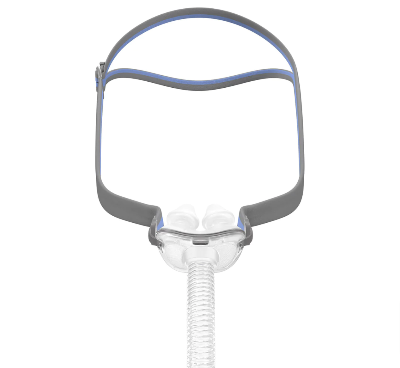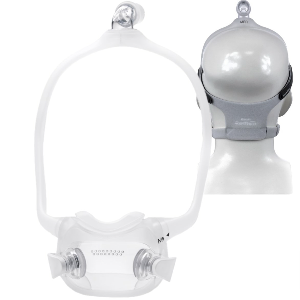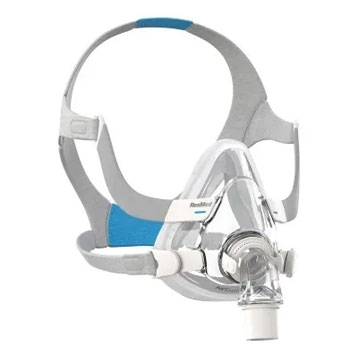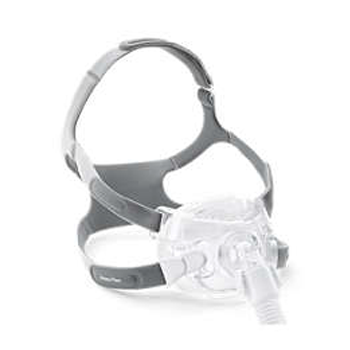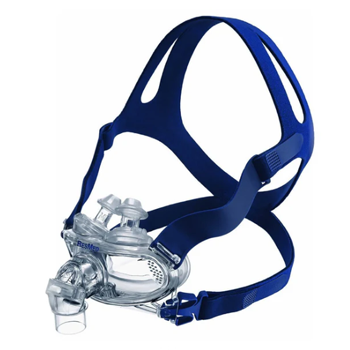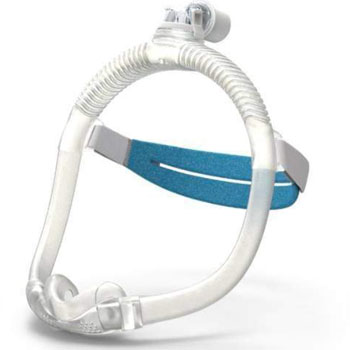Editor’s note: The FDA has issued a recall alert for the ResMed AirTouch F20. The reason for the recall is that ResMed is updating the labeling and warnings on this product, as it contains magnets that could interfere with the functioning of certain medical implants or devices, which the FDA warns could cause “serious harm or death.” For more on the recall, you can visit the full statement from the FDA.
Continuous positive airway pressure (CPAP) treatment is a popular method of treating sleep apnea. Consistently using your CPAP has been shown to reduce the risk of complications like heart disease1, stroke, and diabetes, which can arise when sleep apnea is left untreated.
However, people still tend to struggle with sticking with CPAP treatment. This can be for a variety of reasons, but one of the reasons is that some people have difficulty adjusting to the CPAP mask2. After all, if you’re using a mask that doesn’t fit, it won’t work well, and then you’ll be unlikely to stick with CPAP therapy.
So today, we have rounded up the best-rated CPAP masks of 2024. These masks should not only feel comfortable but also work better than most so that you can stick with the treatment you need.
After we discuss our favorite masks, we’ll also give you a full breakdown of different masks and how to choose the right one, as well as answer your most frequently asked questions.
Best CPAP Masks
- ResMed AirFit™ P10 Nasal Pillow CPAP Mask – Editor’s Pick
- Philips Respironics DreamWear Nasal CPAP Mask – Best Nasal CPAP Mask
- ResMed AirTouch F20 – Best Full Face CPAP Mask
- Philips Respironics Amara View Full Face – Best Value CPAP Mask
- ResMed Mirage Liberty – Most Comfortable CPAP Mask
- ResMed AirFit N30i Starter Pack – Best CPAP Mask for New CPAP Users
Advice from a Medical Expert
We reached out to Dr. Raj Dasgupta, who has over 20 years of experience in the medical field, to see his thoughts on the most important features people should look for in a CPAP mask.
“Look for a CPAP mask that’s comfortable, fits well, and works with your machine and pressure settings. Make sure it comes in different sizes, is easy to clean, and feels sturdy enough to last. That way, you’ll have a mask that’s both effective and hassle-free to use every night.”
ResMed AirFit™ P10 Nasal Pillow CPAP Mask – Editor’s Pick
ResMed AirFit P10 Nasal Pillow CPAP Mask
The ResMed AirFit P10 is a quiet nasal mask with a unique split-strap headgear design that’s easy to adjust and allows full visibility.
Lofta Score
4.50 / 5
Why the ResMed AirFit™ P10 Earned Editor’s Pick
If you’re looking for a lightweight and unobtrusive mask, the ResMed AirFit P10 is about as good as it gets. This mask is designed simply, with elastic headgear that easily and delicately loops around the back of the head. It can do this because the mask itself is very small and light.
The mask design is a nasal pillow, meaning it only covers the nostril area. Air pressure enters the nose through two soft, low-profile nasal pillows (that go slightly into the nostrils). This design is ideal for those who breathe through their nose, sleep on their sides or stomachs, and prefer masks that don’t cover their face as much.
The AirFit P10 is not just lightweight and comfortable, though; it is also so effective that it won a Red Dot Award for its product design.
Our Take: This is an ideal mask for nose breathers who have lower pressure settings, sleep on their side or stomach, or wear glasses. If you have higher pressure settings or move around a lot during sleep, its construction might be a bit too delicate for you.
What We Liked
- Its minimal contact design – This mask covers about as little of the face as you can hope for with a CPAP mask, making it ideal for those who feel claustrophobic, who wear glasses, or who have facial hair.
- It’s quiet – According to ResMed, this mask makes just 21 decibels of sound, which is quieter than the industry standard.
- Easy to adjust headgear – The QuickFit headgear clip included on this mask should make adjusting and readjusting your headgear fast and easy.
Potential Drawbacks
- Won’t work as well for high pressure – If you have more severe sleep apnea and require high-pressure settings, this mask won’t work as well3 for you as a nasal mask or a full-face mask would.
- Won’t work for mouth-breathers – If you breathe through your mouth during the night, nasal pillow and nasal masks will not work to treat your sleep apnea. Instead, you’ll want to look at hybrid or full face masks.
- Not as stable as other masks – If you are someone who moves around a lot during sleep, experts recommend a nasal mask4, rather than a nasal pillow mask.
Philips Respironics DreamWear Nasal CPAP Mask – Best Nasal CPAP Mask
Philips Respironics DreamWear Full Face CPAP
The Philips Respironics DreamWear nasal mask is lightweight and comfortable to wear as it makes minimal contact with your face. The mask allows a full range of movement and is a good option for various sleeping positions.
Why the Philips Respironics DreamWear Earned Best Nasal CPAP Mask
The Philips Respironics DreamWear Nasal mask is our favorite nasal mask out there right now. Just like our Editor’s Pick above, this mask is lightweight and makes minimal contact with the face. However, this one is a nasal mask, rather than a nasal pillow mask. This means it does not have small, soft prongs that insert into the nose; rather, it just surrounds the bottom part of the nose, creating a seal to deliver air pressure.
The mask itself is simple and softer than other masks, making it a good option for side and even stomach sleepers. In fact, the tubing on this mask connects at the top of the head (rather than from the nose/mouth area), so sleepers should have a comfortable, full range of movement without having to worry about their hose tangling.
Our Take: This is one of the least bulky and softest nasal masks on the market, making it a comfortable option for most sleepers. That said, the nasal cradle may not provide as good of a seal for some people.
What We Liked
- Minimal contact – This mask makes minimal contact with the face, allowing for freedom of movement. This can be helpful for combination sleepers who often change positions at night.
- Wide field of vision – People who wear glasses or feel claustrophobic in bulkier masks should love the full field of vision this mask provides.
- Extremely soft materials – Both the frame and nasal cushion are made from soft and flexible silicone.
- Works with facial hair – Because of the minimal contact this mask makes with the face, it should be a good fit for most people with facial hair, still allowing for a solid seal around the nose.
Potential Drawbacks
- A less reliable seal – Since this mask does not go into the nostrils at all, some people find that it doesn’t seal as well, making air leaks more likely. This will depend on your individual nose and sleep position, though.
- Not ideal for high-pressure settings – The lightweight, flexible, and soft material of this mask, as well as its minimal contact headgear, may make it too delicate to handle higher-pressure settings.
ResMed AirTouch F20 – Best Full Face CPAP Mask
ResMed AirTouch F20 Full CPAP Face Mask
A full-face CPAP mask offering great cushion and minimal noise.
ResMed Score
4.80 / 5
Why the ResMed AirTouch F20 Earned Best Full Face CPAP Mask
The ResMed AirTouch F20 is a staple in the ResMed family, seen as a reliable mask with few bells or whistles. This mask fits over both the nose and the mouth, which makes it a good fit for those with high-pressure needs or who breathe through their mouth.
Unlike some other full face masks that use silicone, this one uses an ultra-soft memory foam padding to reduce the pressure on the face and create a more reliable seal. This material also means less cleaning is necessary, according to ResMed, and it may provide a more comfortable seal, particularly for those with facial hair or more oily skin.
Our Take: Finding a full-face mask that fits comfortably can be hard, but this one seems to fit snugly without feeling overbearing. It should provide a better seal than most nasal masks, making it a great option for higher-pressure settings.
What We Liked
- Works with facial hair – Some full face masks won’t seal well with facial hair, but with its memory foam padding, this one should provide a solid seal for you.
- Works for sensitive skin – Some people may experience an allergic reaction5 to the silicone in certain CPAP masks. The memory foam material used in this mask is a good fit for those who are irritated by silicone.
- It’s quiet – This mask includes ResMed’s QuietAir vent, which reduces noise to just 21 decibels. This is helpful for light sleepers who are easily bothered by noise at night.
- Easy to remove – This mask features quick-release elbows, which make it easier to snap on and off if you need to get up in the middle of the night.
Potential Drawbacks
- It uses magnets – This mask uses magnets so you can more easily remove it. This should be fine for most, but those with certain medical devices or implants6 should avoid using masks with magnets.
- It won’t work with glasses – Since this mask comes up high along the bridge of the nose, you won’t be able to wear glasses with it. While this should be fine for sleep, you may not be able to read or watch TV using your CPAP device.
- Difficult to wash – Some users report that this mask is more difficult to wash than some masks with a simpler design.
Philips Respironics Amara View Full Face – Best Value CPAP Mask
Why the Philips Respironics Amara View Earned Best Value CPAP Mask
One of the top complaints about full face masks is that they typically don’t allow for a full field of vision, or for people to wear glasses. This is because full face masks often come up high on the bridge of the nose and between the eyes.
Philips kept this in mind, though, when designing the Amara View. With this mask, you’ll get the benefits of a solid, sturdy seal, as well as a clear field of vision. They’ve done this by creating a very low profile, so this mask only comes up midway along the nose.
Along with these great benefits, the Amara View costs less than similar masks on the market, making this one a great option for those on a tighter budget. For this reason, we picked this as our ‘Best Value’ product.
Our Take: This mask is ideal for those who need a full face mask but who either dislike the cumbersome feel or prefer a full field of vision. The quality of this mask at this price also makes it an excellent value.
What We Liked
- Low profile design – This mask should provide a clear field of vision as well as reduce the risk of discomfort or facial marks along the bridge of the nose.
- Quick-release tube connection – Simply pushing two tabs allows you to disconnect during the night without having to readjust the headgear. This is helpful if you need to get up to use the bathroom in the middle of the night.
- Minimal facial contact – Unlike other full face masks, this one makes minimal contact with the face. This is good news for those who wear glasses or feel claustrophobic in a more cumbersome mask.
- Good for high-pressure needs – A full face mask like this one will work well for those with higher pressure settings.3
Potential Drawbacks
- May not be comfortable for side sleepers – Even though this mask makes less contact than other full face masks, it still may not be quite as comfortable for side sleepers as a nasal or nasal pillow mask.
- Headgear uses magnets – Magnets should be fine for most sleepers, but for those with certain medical implants or devices, masks with magnets should be avoided.6
ResMed Mirage Liberty – Most Comfortable CPAP Mask
ResMed Mirage Liberty CPAP Mask
A smaller hybrid CPAP which combination sleepers love. Easy to clean and has multiple size options.
ResMed Score
5.00 / 5
Why the ResMed Mirage Liberty Earned Most Comfortable CPAP Mask
The ResMed Mirage Liberty is a hybrid mask designed as a more comfortable alternative to traditional full-face masks. It covers the mouth, but rather than encompassing the whole nose, it simply includes nasal pillows. You can think of it like an oral face mask (covering the mouth) combined with a nasal pillow mask, rather than a full nasal mask.
Plus, the mask frame is light and soft, and the dual-wall nasal pillows have “trampoline action” for improved comfort and seal.
It ships with three different pillow sizes, so you can try them on and use the one that feels the most comfortable.
Our Take: The Mirage Liberty combines the benefits of a full-face mask with the benefits of a nasal pillow mask. It should be a great fit for people who occasionally breathe from their mouth but still want a minimal coverage mask.
What We Liked
- No nasal bridge discomfort – Some people complain that full face and nasal masks cause marks and soreness along the bridge of the nose. This one makes no contact with the bridge of the nose, which can make for a more comfortable night’s sleep.
- Diffused air vent – This means the air won’t blow outward from the mask, potentially irritating a bed partner.
- Full field of vision – This mask is one of the lowest profile full-face masks we’ve seen, allowing for glasses and a full field of vision.
- Works for mouth or nose breathers – This should be a good fit for those who breathe from their nose, mouth, or a combination of the two.
Potential Drawbacks
- Takes some getting used to – Nasal pillows may take some getting used to at first since they insert slightly into the nostrils. If you prefer something that doesn’t go into the nose, a nasal mask or a traditional full face mask should work.
- Louder than other ResMed masks – Other ResMed masks on our list emit just 21 decibels of sound, however, this one comes in at 28 decibels7.
- May not work well with a higher setting – Most full face masks work well with a high-pressure setting. However, since this is technically a hybrid with nasal pillows, it may work best with pressure settings under 15 cm H2O.3
ResMed AirFit N30i Starter Pack – Best CPAP Mask for New CPAP Users
ResMed AirFit N30i Starter Pack
The Res Med AirFit N30i Starter Pack is designed for new users. It’s a low-profile nasal mask with soft cushions that make it easy to get used to wearing a CPAP mask.
Why the ResMed AirFit N30i Earned Best CPAP Mask for New CPAP Users
The ResMed AirFit N30i Starter Pack is specifically designed for people who may be new to using CPAP devices. The mask itself is a low-profile nasal mask, with soft cushions that gently seal around the bottom of the nose, rather than prongs that go into the nose, or a mask that covers more of the face. This minimal contact design makes it ideal for those beginning CPAP treatment who won’t yet be used to wearing a mask while they’re sleeping. This also provides for a full field of vision.
We also like the quick-release elbow, which makes this mask easier to disconnect during the night for any late-night bathroom trips. The AirFit N30i Starter Pack also comes with multiple cushion sizes, assuming newer users won’t be as familiar with what size will work for them.
Our Take: This starter pack is ideal for those who are new to CPAP use or new to nasal masks and don’t yet know their nasal cushion size. It’s also a great choice for seasoned CPAP wearers who love a low-profile, minimal-contact mask.
What We Liked
- Top of the head hose connection – This allows sleepers to change positions throughout the night without worrying about tangling their hose.
- Low profile design – Low profile masks are a great fit for those who wear glasses, watch television, or read before bed.
- QuietAir Vent – ResMed’s QuietAir vent helps minimize the noise when you exhale, allowing for a better night’s sleep for you and anyone nearby.
- Multiple cushion sizes included – This is ideal for those new to CPAP therapy who may not know which cushion size is right for them.
Potential Drawbacks
- Won’t work for mouth-breathers – If you usually breathe from your mouth during sleep, this mask, which only delivers air through the nose, will not work for you. Instead, a full-face mask would be a better fit.
- Won’t work with congestion – This mask won’t be able to deliver the air pressure you need if your nose is stopped up due to a cold or allergies.
- Possible leakage – Some users report air leaks with this nasal cradle mask when they move around during the night. This is likely because the mask is soft, flexible, and goes around (rather than into) the nose.
How to Choose a CPAP Mask
When you receive a prescription for CPAP therapy, your doctor will provide specific guidelines on the type of device you should use, including the mask type.
Explore our picks for the Best CPAP Machines.
Type of Mask
CPAP masks come in a variety of styles but generally fall into the following categories: full face, nasal, nasal pillow, or hybrid.
“The best CPAP mask for easing OSA symptoms depends on your personal preferences. Some people prefer nasal masks or nasal pillow masks for their minimal face coverage. Full-face masks cover both the nose and mouth, helpful for mouth breathers or those dealing with congestion.”
Dr. Raj Dasgupta
Full Face
If you require higher pressure settings or breathe through your mouth, a full face design may be recommended. These are usually larger than nasal options and cover the entire face including the mouth and nose. Having a larger surface area means that greater pressure can be delivered without irritating the eyes or airways.
More: Best Full-Face CPAP Mask
Nasal Mask
Nasal frames sit on the face around the nose and are held in place by headgear (stretchy straps that go around the head). Since a standard nasal pillow seals over the nose, providing more coverage, it can deliver more air pressure than you’d get from a nasal pillow mask.
See our picks for the Best Nasal CPAP Masks
Nasal Pillow
A nasal pillow has a small cushion that creates a seal at the base of the nostrils. This is one of the least invasive frames available, making it a popular choice. There is very little contact with the face and no obstruction of view, so you can continue to enjoy activities like reading or watching TV before bed. Tossing and turning shouldn’t be an issue either since this design creates a tight seal and isn’t prone to leaks. Nasal pillows are a good option for nose breathers and anyone with facial hair that prevents other types of masks from staying in place.
Hybrid Mask
As the same suggests, hybrid CPAP masks combine two different designs into one mask style. Like a full face mask, these cover the mouth. However, rather than also covering the nose, they rest beneath the nose with two nasal pillows instead. This means hybrids could be helpful for those who want something less cumbersome than a traditional full face mask or more field of vision.
Additional CPAP Mask Considerations
Price
Your budget may be an important factor when you are purchasing a mask, and this will also depend on whether your insurance will help cover CPAP costs. Most options range in price, with full face frames being the most expensive. Some models come with extra cushions in various sizes or for replacement, adding extra value.
Size, Compatibility, and Comfort
CPAP masks come in various sizes to fit different face structures and shapes. Some models come with multiple cushion sizes, giving users ample flexibility to find the right fit, and many companies now offer specialty options designed in smaller frames for females or children.
Comfort is very important when it comes to choosing a frame and could determine how likely you are to stick with your therapy. Some models have added features to enhance comfort like extra padding and softer materials. Facial hair, dentures, and eyeglasses are all factors that may influence which option works best for you.
Learn More: Best CPAP Masks for Women, Best CPAP Masks for Children, and Best CPAP Mask for Beards
The Mask’s Weight
CPAP masks are generally very lightweight, but full face frames tend to be the heaviest. Headgear that is made of silicone may add extra weight versus fabric straps.
Replaceable Cushions
Many frames feature detachable cushions that can easily be swapped out for different sizes or replaced over time. Most cushions should be replaced every few months or when they start to show signs of wear and tear.
Construction Materials
The majority of CPAP frames on the market today are latex-free and made from silicone-based materials. Many models have removable cushions that are made from cloth, gel, or foam. The straps may also be silicone-based or made from a stretchy fabric material with elastic inside.
That said, it’s important to be mindful of any allergies you have to certain materials, including silicone, as these could trigger a reaction.5
Pressure Settings
The pressure settings are determined by your physician and are generally included in the prescription. Higher settings can irritate the nose, so full-face designs are often recommended. Nasal frames work well with low to moderate-pressure settings, although some have been specifically designed to work well at higher settings too.
Stuffy Nose or Nasal Congestion
If you frequently experience a stuffy nose or nasal congestion, CPAP therapy that is delivered through a nasal frame may not be the best option. In order to be effective, nasal frames require clear passages. Full face frames deliver air through both the mouth and nose and are a good option if nasal passages are blocked or congested.
Warranty
Most frames come with a limited manufacturer’s warranty that will replace or repair any defective parts free of charge. These warranties are generally 90 days long, although some companies may offer extended warranties up to two years. The headgear may be included or in some cases has its own separate warranty.
Maintenance
It’s vital to clean your CPAP mask to prevent bacteria growth. Experts advise cleaning8 the mask cushion or nasal pillows daily and the remaining system and header weekly. These components should be cleaned by hand using a mild soap and warm water (avoid using harsh soaps, chlorine bleach, antibacterial or alcohol-based solutions).8
Your Sleeping Position
Although your healthcare provider will provide guidance on the appropriate mask type to get, it’s also good to know which masks might be more comfortable for certain sleep positions. For example, side, stomach, and combination sleepers may want something more flexible, such as a nasal, nasal pillow, or hybrid mask. Back sleepers, on the other hand, essentially have their pick when it comes to CPAP masks since their face isn’t pressing into the pillow, and this position is usually best for full face masks.
Seal
How well the mask creates a seal for the flow of air is also important for preventing leaks as any leakage could compromise the amount of air pressure you receive. Your mask should be comfortable but still provide a solid seal. If you’re unsure, it’s helpful to consider masks that offer some adjustability so you can have a better chance of getting a good fit for the seal and overall comfort.
Parts of a CPAP Mask
| Item | Description |
|---|---|
| Headgear | Nasal and full face frames are held in place by stretchy traps known as ‘headgear’. Straps may be fabric-based with elastic inside or silicone. Masks may have a single strap that wraps around the back of the head or multiple straps that join together at the crown. The straps are also how you can adjust the fit to create a comfortable but effective seal. Most have buckles, clips, or hook-and-loop closures so you can quickly and easily put the mask on/off. |
| Mask Frame | The frame is the main component of the mask and is what makes direct contact with the nose or face. This is where the air is delivered to and is held in place by headgear. Most frames have cushioning that is built-in or can be attached to improve comfort. |
| Mask Cushion | In order to prevent leaks, the frame needs to create a tight seal over the face or nose. This can lead to irritation or pressure sores where the frame and skin make contact. The cushion helps to minimize pressure and increase comfort by creating a soft barrier. |
| Tubing/Hose | The tubing is what connects the main CPAP box to the frame. Standard tubing is usually 6 feet long to allow enough room for movement during sleep. Longer hoses can be purchased separately and may have extra features like copper for heating. |
Frequently Asked Questions
How much do CPAP masks cost?
CPAP mask costs vary depending on the type of mask, the brand, and whether or not you are using insurance to help cover the mask’s costs. Without insurance, CPAP masks should cost somewhere in the range of $50 to $2009
Which CPAP mask is best?
The type of CPAP mask you choose will be based on your individual needs. For example, if you have high air pressure settings or you breathe through your mouth when you sleep, a full face mask will be your best mask. If you have lower pressure settings, breathe through your nose, and move around a lot during sleep, a nasal pillow mask might be best. We also advise letting your healthcare provider know about your sleep style and any concerns or questions you may have on this.
What is the easiest CPAP mask to get used to?
If you’re new to CPAP therapy, a low-profile nasal mask might be the easiest mask type to get used to. These make less contact with the face, allow for a full field of vision, and do not have prongs that go into the nose, which may be hard to get used to.
What CPAP mask is best for mouth breathers?
People who breathe through their mouths during sleep will need to use either a hybrid or full face mask. People who breathe through their mouths will not be able to effectively use nasal or nasal pillow masks.
Which CPAP mask leaks the least?
Any mask has the capability of leaking if it doesn’t fit right. That said, Mayo Clinic recommends a full-face mask or a mask with nasal pillows that are inserted lightly into each nostril to help minimize leaks.2

Natalie Grigson
Writer
About Author
Natalie is a content writer for Sleep Advisor with a deep passion for all things health and a fascination with the mysterious activity that is sleep. Outside of writing about sleep, she is a bestselling author, improviser, and creative writing teacher based out of Austin.
Combination Sleeper
References:
- Wickwire PhD, Emerson M., et al. “CPAP adherence is associated with reduced risk for stroke among older adult Medicare beneficiaries with obstructive sleep apnea”. Journal of Clinical Sleep Medicine. 2021.
- “CPAP machines: Tips for avoiding 10 common problems”. Mayo Clinic. Last modified November 29, 2023.
- Deshpande, Sheetal., et al. “Oronasal Masks Require a Higher Pressure than Nasal and Nasal Pillow Masks for the Treatment of Obstructive Sleep Apnea”. Journal of Clinical Sleep Medicine. 2016.
- “Slide show: Which CPAP masks are best for you?: Nasal masks”. Mayo Clinic. Last modified March 3, 2023.
- Prasad, Aman., Reeder, Margo J. “Allergic contact dermatitis to silicone in a continuous positive airway pressure mask”. Contact Dermatitis. 2020.
- “Updated Information on Masks with Magnets for Mask Users”. ResMed. Webpage accessed December 13, 2023.
- “Mirage Liberty™ User Guide”. ResMed. 2012.
- “CPAP Equipment Cleaning and Disinfecting Instructions”. Weill Cornell. Webpage accessed December 15, 2023.
- Ikpeze, Tochukwu. “How Much Do CPAP Machines Cost?”. SleepApnea.org. Last modified May 4, 2023.

